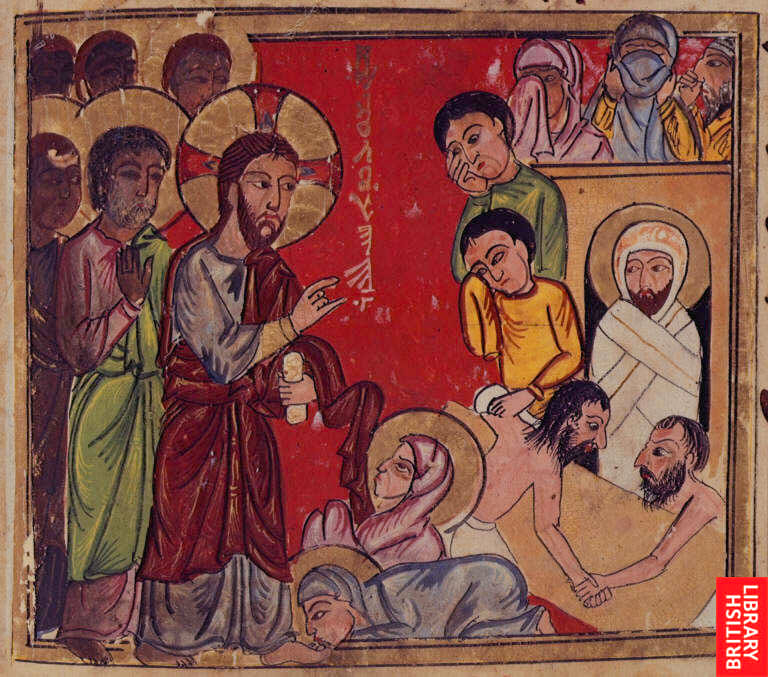1. The Sixth Friday of Great Lent – Lazarus’ Friday.
According to our Liturgical Calendar, the Sixth Friday of Great Lent is when we commemorate Maran Isho M’shiha raising Lazarus from the Dead, and hence, it is known as Lazarus’ Aruvtha (Friday). In our Liturgical Calendar, the event of the raising of Lazarus is the Evangelion that falls on this Aruvtha (Friday). The event of the raising of Lazarus is a foreshadowing of Ishos’ Passion and Death (Yohannan 11:53) and Resurrection (Yohannan 11:25). Invoking thoughts of the Passion and Death, but above all, by preparing our souls for the Resurrection of Maran (our Lord), Lazarus’ Friday points us towards these Rāzē (mysteries).
2. The Sixth Saturday of Great Lent –
Lazarus’ Saturday – Kozhikotta Saturday. All Oriental Churches commemorate the Saturday before Palm Sunday as Lazarus’ Saturday. As a Thanksgiving to Isho, the events of the feast as Lazarus’ home, as well as Mariyam anointing the feast of Yohannan (Yohannan 12:1-8) is remembered on this day. In the context of Nazrani households, kozhikotta is made on this day. ![]() 6 days before Pesaha, as Isho was going to Orshlem, He went to and ate at the House of Lazarus (Yohannan 12:1-8). On that day, Lazarus’ sister Mariyam made a special food and gave it to Isho. So by making the special food that is Kozhikotta, we commemorate this event. Remembering the fragrance which Mariyam used, Sarkara and coconut is put in the Kozhikotta, which the Head of the Family drew a Sliva upon and then have to the family. Because of this, this day is also known as Kozhikotta Saturday. Isho interpreted the anointing done by Mariyam as a symbol of His burial.
6 days before Pesaha, as Isho was going to Orshlem, He went to and ate at the House of Lazarus (Yohannan 12:1-8). On that day, Lazarus’ sister Mariyam made a special food and gave it to Isho. So by making the special food that is Kozhikotta, we commemorate this event. Remembering the fragrance which Mariyam used, Sarkara and coconut is put in the Kozhikotta, which the Head of the Family drew a Sliva upon and then have to the family. Because of this, this day is also known as Kozhikotta Saturday. Isho interpreted the anointing done by Mariyam as a symbol of His burial.
3. The Last Monday of Great Lent – Lazarus’ Monday –
The remembrance of Bethany. The East Syriac Church has a third day remembering Lazarus. The Evengeliyon reading on Monday is where Martha and Mariyam, in the presence of Lazarus, go to Bethany to prepare the feast for Isho. This day’s Lelya begins in the Porch as it is the symbol of Bethany. The worshippers stand in the porch with the Sliva, Evangelion (Gospel), lighted candles, Maksaneesa, incense, and Palm leaves. After the beginning of Lelya, at the last line of the second Mawtha, the procession moves to the Qanke. At the end of the procession, the Sliva and Evangelion are placed on the Madbaha.
Lazarus’ house was in Bethania. After Palm Sunday, until Pesaha, Isho resided in Bethania. He went from there to Orshlem. As a commemoration of Isho s’ journey from Bethania to Orshlem, the procession from the Porch to the Qanke is done.
In this way, the three events associated with Lazarus in the Evengeliyon lead us to the Resurrection of our Lord on the Third Day.
Syro Malabar Eparchy of Great Britain
*നാല്പതാംവെള്ളി* *Lazarus’ Friday**ലാസറിന്റ വെള്ളി*
നമ്മുടെ ആരാധനാവത്സര കലണ്ടറനുസരിച്ച് വലിയനോമ്പിന്റെ നാല്പതാം ദിവസമായ “നാല്പതാംവെള്ളി” ഈശോ ലാസറിനെ ഉയിർപ്പിച്ചതിനെ അനുസ്മരിക്കുന്ന “ലാസറിന്റെ വെള്ളി” എന്ന പേരിലറിയപ്പെടുന്ന ദിനമാണ്.
ഈ ദിനത്തെ ‘നാല്പതാംവെള്ളി’ എന്നു വിളിക്കുന്നതിന്റെ കാരണം ലളിതമാണ്. വലിയനോമ്പു തുടങ്ങിയിട്ടു നാല്പതു ദിവസമായി എന്നർത്ഥം.
ഈശോയുടെ നാല്പതുദിവസത്തെ ഉപവാസമാണ് ഈ വലിയനോമ്പിന്റെ അടിസ്ഥാനം. പിന്നീടുള്ള പത്ത് ദിവസങ്ങൾ കർത്താവിന്റെ പീഡാനുഭവത്തെ അനുസ്മരിച്ചുള്ള നോമ്പാചരണമാണ്. എന്തുകൊണ്ടാണ് നാല്പതാംവെള്ളി ‘ലാസറിന്റെ വെള്ളി’യായത്?
ഈശോ ലാസറിനെ ഉയിർപ്പിച്ച സംഭവമാണ് നമ്മുടെ ആരാധനാവത്സര കലണ്ടർ അനുസരിച്ച് ഈ വെളളിയാഴ്ചയിലെ സുവിശേഷം വിവരിക്കുന്നത്.ലാസറിനെ ഉയിർപ്പിച്ച സംഭവം ഈശോയുടെ പീഡാനുഭവത്തിന്റെയും (യോഹ 11:53) ഉയിർപ്പിന്റെയും (യോഹ 11:25) സൂചനയുമാണല്ലോ.
പീഡാനുഭവചിന്തകളോടൊപ്പം, എന്നാൽ അതിലേറെ, ഈശോയുടെ ഉയിർപ്പിനുള്ള ആത്മീയഒരുക്കമെന്ന നോമ്പുകാലത്തിന്റെ മുഖ്യലക്ഷ്യത്തിലേക്കു “ലാസറിന്റെ വെള്ളി” നമ്മുടെ ശ്രദ്ധ ക്ഷണിക്കുന്നു.

